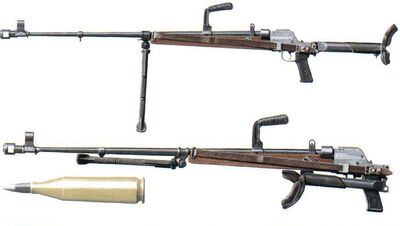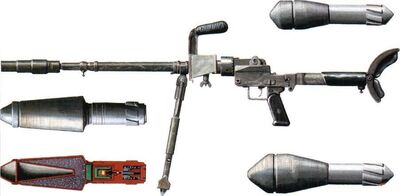The Panzerbüchse 39 (PzB 39) was a German anti-tank rifle used in World War II. Literally Panzerbüchse means "tank rifle"; here, the word Büchse is the term for "rifle" in sports or hunting jargon.
History[]
The origins of the PzB 39 date back to the Mauser 1918 T-Gewehr, created in 1918 in response to the appearance of British tanks on the Western Front. The single shot

The Panzerbüchse 39 is shown in the travelling position (below) and with the bipod lowered and stock extended ready for action (above). German an ti- tank rifles vvere rendered obsolete by the increasing thickness of tank armour.
manually-operated rifle was chambered in a proprietary 13.2x92mmSR cartridge and enjoyed moderate success against contemporary armored vehicles, with approximately 16,000 rifles being built in total.
German anti-tank rifle development resumed in the late 1930s. In an effort to provide infantry with a man-portable lightweight alternative to the TuF Gewehr, Dipl.-Ing. (certified engineer) B. Brauer at Gustloff Werke in Suhl designed the Panzerbüchse 38 (PzB 38). It was a manually-loaded single shot weapon with a recoiling barrel. When fired, the barrel recoiled about 9 cm, which opened the breech and ejected the spent cartridge casing. The breech block was then arrested in the rear position, remaining opened for the gunner to manually insert a new cartridge. The gunner then released the cocked breech with a lever at the grip. The breech and barrel would then move forward again and the trigger was cocked in preparation to fire. This rather complicated mechanism was reportedly prone to jamming as the system got dirty in field use. Although manufactured with pressed steel parts that were spot-welded, still because of the complicated vertical breech block mechanism it was difficult to manufacture and only a small number of 1,408 PzB 38 rifles were built in 1939 and 1940 at the Gustloff Werke plant; 62 of these weapons were used by German troops in the invasion of Poland in 1939.
Development[]
The next development, onto which production was immediately switched, was the Panzerbüchse 39 or PzB 39, an improvement made by the company Gustloff on their PzB 38. It too featured a vertical breech block mechanism. It retained the barrel of the PzB 38 and had an only slightly increased overall length of 162.0 cm; weight was reduced to 12.6 kg. Its performance data was basically the same as that of the PzB 38. To increase the practical rate of fire, two cartridge-holding cases containing 10 rounds each could be attached to both sides of the weapon near the breech - these were not magazines feeding the weapon, they simply enabled the gunner to extract the cartridges (that he still had to manually insert into the gun) from the conveniently placed magazines. 568 PzB 39 were used by the German army in the invasion of Poland; two years later, at the beginning of the war against Russia, 25,298 PzB 39 were in use by German troops; total production from March 1940 to November 1941, when production ceased, was 39,232 rifles. The PzB 39 remained in use until 1944, by which time it had become hopelessly inadequate against all but the lightest armored vehicles.
Variants[]
Starting in 1942, remaining PzB 39 rifles were rebuilt with a shortened barrel (590 mm) and an affixed Schiessbecher ("firing cup") attachment threaded to the barrel and used

The German Granatbüchse 39 was a converted PzB 39 anti-tank rifle fitted with a 'Schiessbecker' grenade la uncher cup on the m uzzle. The grenades fired included small hollow-charge anti-tank grenades (see cross section) that were effective only against the very lightest armour at ranges up to 125 m (136 yards).
to launch standard rifle grenades. The cup was the standard type used with the ubiquitous Kar 98k infantry rifle and the ammunition was also interchangeable; there were three types of grenades: an anti-personnel grenade, a light anti-tank grenade and a large-diameter anti-tank grenade. The grenades were propelled by a special cartridge with a wood bullet. The rifle was also outfitted with a special sighting arrangement for firing up to 150 m and the wooden forend was removed. These converted rifles received the designation Granatbüchse Modell 39 (GrB 39) and remained in use until the end of the war.
Specifications[]
Type Anti-tank rifle
Place of origin Nazi Germany
In service 1940–1944
Used by Nazi Germany
Wars World War II
Designer Gustloff Werke
Designed 1939
Manufacturer Gustloff Werke
Produced 1940–1941
Number built 39,232
Variants Granatbüchse 39
Weight 11.6 kg (25.57 lb)
Length 1,620 mm (63.8 in)
Barrel length 1,085 mm (42.7 in)
Cartridge 7.92x94mm
Action Bolt action
Rate of fire 10 rounds/min (practical rate)
Muzzle velocity 1,210 m/s (3,970 ft/s)
Sights Hooded front post, rear "V" notch